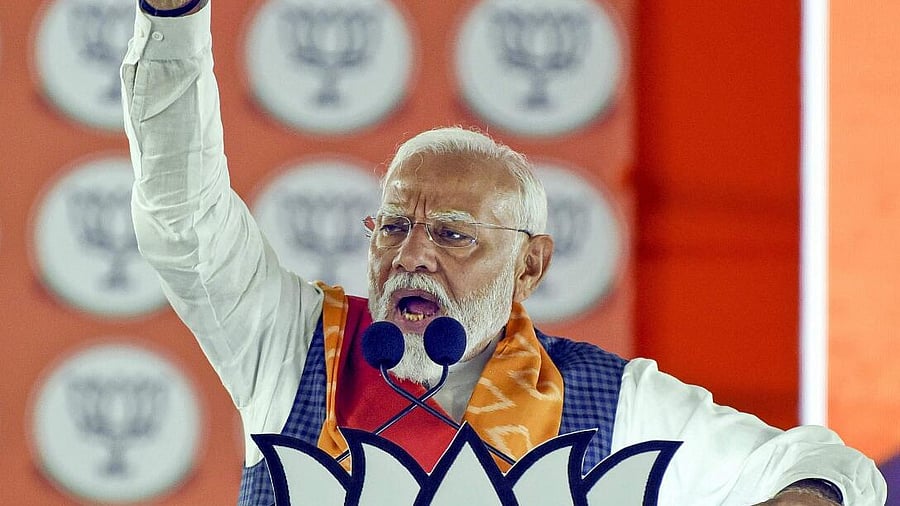
PM Narendra Modi speaks at a public election meeting.
Credit: PTI Photo
In September 2002, months before leading the Bharatiya Janata Party (BJP) to a runaway victory in the first assembly elections in Gujarat under his stewardship, then Chief Minister Narendra Modi embarked on the contentious Gaurav Yatra.
Setting a tone to polarise voters based on their religious identity, he declared its raison d'être as restoration of pride in ‘Gujarati Asmita’ (Gujarati identity), allegedly roundly criticised in the wake of the 2002 riots, although the target of condemnation was the state government and its chief executive for their pronounced majoritarian stance.
With that, Modi initiated the task of raising the electoral behemoth his party has at its command since, first in Gujarat and later across India. The Gaurav Yatra was Modi’s attempt at widening his personage from being the avenger of Godhra to the emperor of Hindu hearts.
A day after launching the virulent campaign on September 8, Modi delivered a speech with communal overtones in the temple-town of Becharaji in Mehsana district.
This speech flagged off Modi’s 2002 polarising campaign. Since then, divisiveness during polls remained his go-to issue whenever he failed to weave an overarching narrative and splintered into multiple or constituency-level issues.
Back then, Modi, speaking disjointedly, claimed that the Congress criticised every action of his government if the Hindus benefited, like the redevelopment of temples. “What brother,” Modi asked mockingly, “should we run relief camps?” (He referred to relief camps for riot-effected Muslims being shut down by the state government).
He added spitefully, “Should I start baby producing centres there?” Before de-escalating this section of his speech, Modi blew the dog whistle with a half-sentence: “Ame panch, Amara panchees,” (we are five and we have 25 — a clear reference to the Sangh parivar’s prejudicial campaign against polygamy and alleged high fertility rate among the Muslims).
Modi’s 22-year-old speech is recalled here because of the similar Islamophobic trope he used on April 21 after the first phase of polling showed lower turnout over 2019, upsetting many in the BJP.
His speech in Banswara, Rajasthan marked a change in emphasis in speeches besides underscoring remarkable consistency in using divisive vocabulary. Instead of highlighting his government’s performance in the fields of economy and social development, Modi shifted his electoral campaign to focus on anti-Muslim rhetoric.
In the run-up to the ongoing polls, the BJP routinely denied accusations that the government targeted religious minorities, especially the Muslims and the Christians. It cited welfare programmes, from free food grains under the Pradhan Mantri Garib Kalyan Anna Yojana (PMGKAY) for five years from January 1, to ongoing schemes like providing free gas connection to households.
The BJP contended that none of these schemes discriminated against the applicants based on their religious identities. But following Modi’s decision to whip up social prejudice against the Muslims, the BJP has stopped displaying such self-issued ‘certificates’.
But once the warning bell was sounded by the low voter turnout after the first phase, Modi lost no time and turned to old ways — depicting the Muslims as usurpers, and the Congress and its I.N.D.I.A. bloc partners as parties that consistently ‘appease’ the Muslims.
The allegation that since Independence, all political parties barring the BJP and its predecessor the Bharatiya Jana Sangh have handled the Muslims with kid gloves has been levelled by the BJP ad nauseam.
In his April 21 speech, Modi picked on the mangalsutra because of its symbolic value for Hindu women. By alleging that the Congress would snatch these from them and hand them over to the Muslims, he attempted to whip up anger towards the Congress, as well as the Muslims.
After resurrecting the old spite-spewing narrative, Modi began repeatedly referring to the Congress manifesto. Political parties, including the Congress and the BJP, are known to conveniently forget some (or many) of the promises made in their manifestoes once voted to power. Modi repeatedly mentioned the Congress litany of promises, except that he distorted the contents of it. For instance, the redistribution of wealth which Modi claimed in Banswara to be the Congress’ goal found no mention in the manifesto.
There are two discernible trends from the new narrative Modi spun: One, there is an attempt at harnessing the Hindu vote by disparaging the Muslims, and by depicting the Congress as favouring people from the minority community.
Two, Modi sharpened his political attacks on Rahul Gandhi — distorting his statements to say that the former Congress president will do an ‘X-ray of wealth’, distribute it to 'select' people, impose an ‘inheritance’ tax, and also take away reservations from the socially underprivileged sections and allot quota to the Muslims.
Furthermore, Modi terming Gandhi as shehzada, pejoratively used for a prince of a Muslim emperor, a term he has not used for years, underscores his changed tack. Clearly, Modi’s speeches since April 21 show an anxiety not witnessed in previous elections in 2014 and 2019. Like always when unsure, the attempt is to whip up communal passions.
Communal polarisation, and targeting of Muslims, come with risks. Despite the Election Commission’s slothfulness in probing allegations of Modi violating the Model Code of Conduct through his speeches, he has now made a belated attempt to clarify that he did not denigrate the Muslims with his ‘people with more children’ remark. As Gujarat’s chief minister, Modi alternately projected himself as Hindu Hriday Samrat and Vikas Purush. Likewise, his one dimension is now marketed by publicists as ‘welfare driven’, while the other furthers communal polarisation. So far, the gullible believed he had forsaken divisiveness, and, thus, backed him. Beyond a point, it will be tough to convince people that his words are not communal.
(Nilanjan Mukhopadhyay, a Delhi-based journalist, is author of 'Narendra Modi: The Man, The Times'. X: @NilanjanUdwin.)
Disclaimer: The views expressed above are the author's own. They do not necessarily reflect the views of DH.